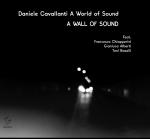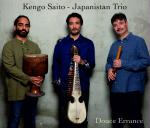

The Italian record company Taranta is launching a special series of discs devoted to the many other kinds of music to be heard in Italy. Their Ethnica Symphonia label kicks off with the Andalucían born flamenco guitarist Tomás de los Reyes, who both plays and sings on this CD.
The CD notes tell us that de los Reyes was born in 1954 to gypsy parents in Huelva, one of the heartlands of flamenco. His father was a flamenco dancer and apparently so despaired of ever finding an accompanist that he swapped his horse for a guitar, hoping that one of his sons would learn well enough to be able to play for him. Tomás did indeed learn well, and became able to support himself by playing and teaching in Spain and Europe before eventually settling with his family in Italy.
De los Reyes has a good technique and is well versed in the characteristic motifs and phrasing of flamenco guitar of the fifties, sixties and seventies. Mastery of this vocabulary has always been a kind of rite of passage for flamenco guitarists. Since then different sonorities, chordings, riffs and pulse patterns have rippled through the flamenco ocean, yet with de los Reyes one almost feels they might never have occurred. There are plenty of echoes of the old masters' styles in his playing but of the true innovators of the late twentieth century there is hardly a trace. Of course the playing of the former is valid and beautiful for all time, but half a century on, dishing up this familiar material hardly seems a reason to make a CD. After a while this listener was beginning to wonder if subversion or irreverence was ever going to put in an appearance and by the end I was disappointed. True, de los Reyes puts some of his own ideas into the Granainas (2) and Malagueňa (8) for example, but too often I was left with the feeling that the tyranny of the recording studio had caused him to play safe. If Tomás does have a style of his own, we don't get much of a chance to hear it on this recording.
De los Reyes assays most of the basic toques (flamenco styles). At over 75' in length my feeling is that this disc is a kind of musical market stall of available goods rather than a delivery of choicest items. Little thought seems to have been given to a running order that would have taken the listener on an emotionally varied voyage. The CD would definitely have a stronger impact if the weaker numbers had been left off, the Farruca for example, which, although described in the notes as an 'instrumental piece and dance of a proud and high spirited nature' comes across here as rather a plod. However, dance aficionados may find much useful material here, particularly as de los Reyes has included several tracks in which he accompanies dancer María Gómez whose clean zapateado is well audible.
For me the moments on this disc when something happens is when de los Reyes decides to sing ( 3, 6, 7, 9, 11, 13, 14). You may or may not like his voice, but there is an intensity there that seems absent from the lonely guitar.
It's unfortunate that de los Reyes is not served well by the recorded sound, which is dull and captures little of the characteristic nervous sonority of the flamenco guitar. Once or twice his compás (rhythmic pulse) slips and becomes wayward. It's a pity he wasn't given the chance to do a retake to cover these little fluffs.
The CD booklet is in Italian, Spanish and English. The original Italian has been translated in its entirety into Spanish but, for lack of space, only the song descriptions have been given in English. Where Ethnica scores is in presenting the text of the sung flamenco in Spanish and Italian. This is all too rare in flamenco CDs, but surely essential, for song is at the heart of flamenco, and an understanding of the lyrics can be a real help to outsiders. In Andalucía, the singer, supported by a guitar accompanist, is the star. Dancers, loaded with the baggage of choreographed routine, often seem to be a visual interlude to the main business. Outside Andalucía the roles are reversed. In the world of touring flamenco shows, the dancer with legs like pneumatic drills is the centre of attention, the singer is yelling about God-knows-what, whilst the hard-working guitarist thrashes away in the background.
The English translation seems hastily done, 'casi tenebrosa' (almost gloomy) being rendered as 'almost tenebrous' for example. Sometimes the notes are misleading. For instance Siguiriya (1) is described as being in the doric mode. It is in fact, like much flamenco, closest to the phrygian. Some styles, for example Alegrías (15), have their compás explained, whilst the rest are left for the listener to puzzle out. For those interested I recommend checking out Juan Martin's excellent guitar tutors, or the writings of Donn Pohren, to find well researched and presented information about the toques played on this disc.
In short, as a compendium of flamenco sounds and styles this disc is useful, but for the real treat, look further.
Our Playlist
Our olaylist on Spotify, dedicated to P
re Minimalism, Minimalism and Post Minimalism.
© 2025 Felmay Srl - P.I. 06974300011 | Powered by: Riccardo Marino























